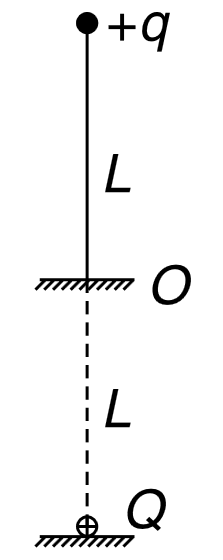A ball of mass 10−2kg and having charge +3×10−6C is tied at one end of a 1m along thread. The other end of the thread is fixed and a charge −3×10−6C is placed at this end. The ball can move in the circulr orbit of radius 1m in the vertical plane. Initially, the ball is at the bottom. Find the monimum initial horizontal velocity of the ball, so that it will be able to complete the full circle.
Step by step video & image solution for A ball of mass 10^(-2) kg and having charge + 3 xx 10^(-6)C is tied at one end of a 1m along thread. The other end of the thread is fixed and a charge - 3 xx 10^(-6) C is placed at this end. The ball can move in the circulr orbit of radius 1m in the vertical plane. Initially, the ball is at the bottom. Find the monimum initial horizontal velocity of the ball, so that it will be able to complete the full circle. by Physics experts to help you in doubts & scoring excellent marks in Class 12 exams.
Updated on:21/07/2023Topper's Solved these Questions
- ELECTROSTATIC FORCES, CHARGES AND FIELDSBOOK - SL ARORACHAPTER - ELECTROSTATIC FORCES, CHARGES AND FIELDSEXERCISE - Problems For Self Practice
1 Videos
- ELECTROSTATIC FORCES, CHARGES AND FIELDSBOOK - SL ARORACHAPTER - ELECTROSTATIC FORCES, CHARGES AND FIELDSEXERCISE - Problems For Self Practice
1 Videos
- ELECTRONS AND PHOTONSBOOK - SL ARORACHAPTER - ELECTRONS AND PHOTONSEXERCISE - TYPE E : Problem For Self Practice
11 Videos
- HEATING EFFECT OF CURRENTBOOK - SL ARORACHAPTER - HEATING EFFECT OF CURRENTEXERCISE - All Questions
192 Videos
Similar Questions
A 10-kg ball is dropped from a height of 10 m. Find the initial potential of the ball.
View SolutionA small particle of mass 1.8×10−30 kg and charge −3.5×10−19 C is dropped in a region of electric field of strength 2.8×105NC−1, directed in the upward direction. Calculate the time taken by the ball to cover a distance of 2 cm.
View Solution
Knowledge Check
A particle of mass 6.4×10−27 kg and charge 3.2×10−19C is situated in a uniform electric field of 1.6×105Vm−1. The velocity of the particle at the end of 2×10−2m path when it starts from rest is :
A2√3×105ms−1B8×105ms−1C16×105ms−1D4√2×105ms−1A pith ball carrying a charge of 3×10−10C is suspended by an insulated thread of length 50cm.When a uniform electric filed is applied in a horizontal direction , the ball is found to deflect by 2cm from the vertical. If the mass of the ball is 0.5gm , the intensity of the electric field is :
A6.6×105N/CB3.3×105N/CC9.9×105N/CD1.1×105N/C
Two point charges 3×10–6C and 8×10–6C repel each other by a force of 6×10–3 N. If each of them is given an additional charge – 6×106 C, the force between them will be
View SolutionA ball of mass 100g and having a charge of 4.9×10−5 C is released from rest in a region where a horizontal electric field of 2.0×104NC−1 exists. (a) find the resultant force acting on the ball. (b) What will be the path of the ball ? (c ) Where will the ball be at the end of 2 s?
View SolutionA proton of mass 1.67×10−27 kg and charge 1.6×10−19C is shot a uniform magnetic field, and perpendicular to the field with a velocity 5×106m/s. If the magnetic induction of the field is 1 tesla, find
(i) The radius of the circular path
View SolutionA particle of mass m and charge q is attached to a light insulating thread of length L. The other end of the thread is secured at point O. Exactly below point O, there is a small ball having charge Q fixed on an insulating horizontal surface. The particle remains in equilibrium vertically above the ball with the string taut. Distance of the ball from point O is L. Find the minimum value of Q for which the particle will be in a stable equilibrium for any gentle horizontal push given to it.

View SolutionA simple pendulum consisting of a ball of mass m tied to a thread of length l is made to swing on a circular arc of angle q in a vertical plane. At the end of this arc, another ball of mass m is placed at rest. The momentum transferred to this ball at rest by the swinging ball is
View SolutionA ball of mass 1kg moving with a velocity of 15m/s undergoes a head on elastic collision with another ball of unknown mass at rest, and rebound with a velocity of 10m/s. What is the mass of the other ball?
View Solution
